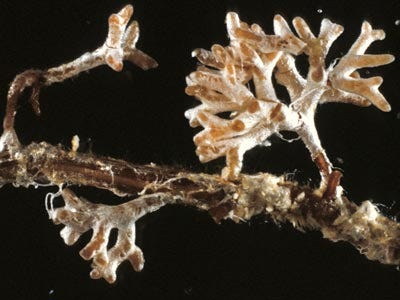Cows can't eat grass
Pharmaceutical companies can't develop pharmaceuticals...
A line in the wonderful Merlin Sheldrake book, Entangled Life, struck me deeply: 'cows can't eat grass.' In the book, Sheldrake covers fungi in all their forms, but naturally spends a good amount of time on 'holobionts' - organisms that can only exist because of the way they work symbiotically with others, of which cows are clearly one example, but so are we.
So, of course, are pharmaceutical companies. If we were to borrow and extend the idea, 'pharmaceutical companies can't develop pharmaceuticals...' Cows clearly do 'eat grass', and pharmaceutical companies do evidently develop and launch pharmaceuticals. But the idea of pharma as a holobiont is more interesting...
This idea ranges from the very obvious, with external but necessary CROs, CSOs and regulators, to the less obvious: most pharmaceutical 'companies' are collections of individuals who go home at the end of the day (or go from study to lounge, these days...). These individuals have agency, and are increasingly able to 'live' somewhere else.
Many stories were ascribed to Dan Vasella, and his hands-on design of the wonderful Basel campus for Novartis - many surely apocryphal - but one I did like was the one about the lovely visitor centre. I was told that the philosophy was 'our visitors are a critical part of who 'we' are, and we can't do anything without them: KOLs, 'vendors', potential employees...'
That mindset is healthy. Most companies go through involution, rather than evolution: ideas folded into the new organism, instead of developed internally through helpful mutation. Like viral DNA, bad ideas and good ideas alike can be brought in and replicated. From in-licensing of compounds, to outsourcing of manufacturing and sales; from seeing how markets are, to engaging patients in studies, pharma companies may be the organising principle rather than a self-sufficient walled garden. That someone could leave a competitor and join your organisation, you might hope, would be an active, rather than a passive choice.
Of course, some companies have developed higher walls and thicker skins, with procurement and other mechanisms to limit flow; likewise age can produce ossification, maintaining old process well beyond its sell-by date, and scale can make it harder for new ideas to reach the centre.
But, if there's a simple take-away, it is that there should be no 'them and us'. The argument still runs on the question of whether it was fungi that co-opted plants, or plants that co-opted fungi to provide root systems and nutrient pathways, but the reality is that each now needs the other, and the better the relationship is managed, the healthier for each organism. Seeing 'vendors' as commensal is probably an unhealthy mindset.
Learning which organisms are helpful, or confer competitive advantage, can be the work of centuries, but setting up experiments to explore novel partnerships seems to have been a method used by some of the more successful holobionts. And so it will be for pharma.


